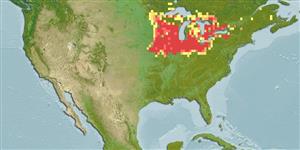Klassifizierung / Names
Namen | Synonyme | Catalog of Fishes (gen., sp.) | ITIS | CoL | WoRMS | Cloffa
Actinopterygii (Strahlenflosser) >
Perciformes (Perch-likes) >
Percidae (Perches) > Etheostomatinae
Etymology: Etheostoma: Greek, etheo = to strain + Greek, stoma = mouth; Rafinesque said "various mouths", but Jordan and Evermann suggest the name might have been intended as "Heterostoma (Ref. 45335); microperca: From the words micro, meaning small, and perca, perch (Ref. 10294). More on author: Jordan, Gilbert.
Lebensraum / Klimazone / Range
Ökologie
; süßwasser benthopelagisch; pH range: 7.0 - 7.8; dH range: ? - 15. Temperate; 10°C - 22°C (Ref. 12468), preferred ?; 47°N - 34°N
North America: Great Lakes and Mississippi River basins from eastern Ontario in Canada and from Minnesota south to southern Ohio, central Indiana and central Illinois in the USA; Ozarks-Ouachita drainages of southern Missouri, southeastern Kansas, northwestern Arkansas and eastern Oklahoma in the USA.
Size / Gewicht / Alter
Maturity: Lm ? range ? - ? cm
Max length : 4.4 cm TL Männchen/unbestimmt; (Ref. 5723); common length : 3.1 cm TL Männchen/unbestimmt; (Ref. 12193); max. veröff. Alter: 2 Jahre (Ref. 12193)
Occur in quiet, vegetated lakes, headwaters, creeks and small rivers (Ref. 5723); also found in streams and springs to ponds (Ref. 10294). Usually found over mud and sand (Ref. 5723, 10294). Adults feed on midge larvae, isopods, and microcrustaceans, particularly copepods (Ref. 10294). Eggs are found attached to the substrate unguarded (Ref. 7043).
Eggs are found attached to the substrate unguarded (Ref. 7043). From Ref. 7043, 'a ripe female is courted by males and when ready to spawn positions herself on vegetation, often vertically. A male mounts the female and clasps her back with his enlarged pelvic fins. The two fish vibrate and one to three eggs are deposited on living or dead vegetation.The pair moves to another spot and more eggs are laid.'
Page, L.M. and B.M. Burr, 1991. A field guide to freshwater fishes of North America north of Mexico. Houghton Mifflin Company, Boston. 432 p. (Ref. 5723)
IUCN Rote Liste Status (Ref. 115185)
CITES (Ref. 94142)
Not Evaluated
Bedrohung für Menschen
Harmless
Nutzung durch Menschen
Mehr Information
PartnerBilderStamps, CoinsLauteCiguateraGeschwindigkeitSchwimmstilKiemenoberflächeOtolithsGehirngrößeSehfähigkeit
Tools
Zusatzinformationen
Download XML
Internet Quellen
